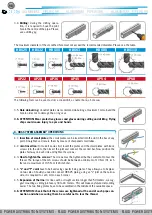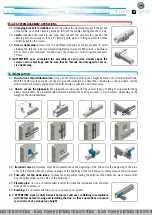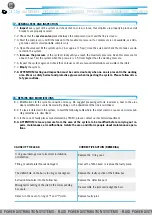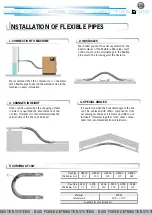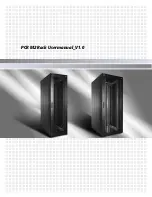
ALUMINIUM PIPEWORK - ALUMINIUM PIPEWORK - ALUMINIUM PIPEWORK - ALUMINIUM PIPEWORK - ALUMINIUM PIPEWORK - ALUMINIUM PIPEWORK
99
FLUID POWER DISTRIBUTION SYSTEMS - FLUID POWER DISTRIBUTION SYSTEMS - FLUID POWER DISTRIBUTION SYSTEMS - FLUID POWER DISTRIBUTION SYSTEMS - FLUID POWER DISTRIBUTION SYSTEMS
6.3. Isolation valves: ball valves must be mounted both at the beginning of the line and at the beginning of the bran-
ches of the main line. Mount a pressure gauge at the beginning of the main line and a safety valve on the air receiver.
6.4. Take-offs: for the down tubes: to prevent any impurities fouling the bottom of the hollow bar, we recommend fit-
ting the outlet plates on the sides of the hollow bar.
6.5. Flexible pipe: its use is recommended in order to isolate the installation from the vibra-
tions of the compressor.
6.6. Earthing: it is recommended in case of stray electrical currents.
6.7. ATTENTION: wear a safety helmet, harnesses and use scaffolding in compliance
with the law before tracing and installing the line, as these operations are usual-
ly carried out at a dangerous height.
5. AP SYSTEM ASSEMBLY OPERATIONS
5.1. Clamping brackets installation: insert one side of the clamping bracket in the groove
of the profile, push both clamping brackets to touch the profiles and tighten the screws.
5.2. Joints: introduce the joint into one pipe, then connect the second pipe, position the
clamping bracket equally so that it is clamping both pipes or fitting and half the other
and finally tighten the screws.
5.3. Screws tightening: Screws must be tightened properly but not excessively, to avoid
stripping the threads. The recommended tightening torque for M5 screws is beetween
9 N·m and 11 N·m maximum. For M6 screws the minimum is 13 N·m and the maximum
15 N·m.
5.4. ATTENTION: once completed the assembly of every joint, double check the
screws correct blockage and be sure that no threads are damaged for exces-
sive tightening.
6. INSTALLATION
6.1. How to trace the distribution line: trace a horizontal line at the chosen height by means of a stretched plumb line.
With the TESEO system you do not need to give the inclination to collect the condensate as the up-column and the
down-column are already equipped at the bottom with a collection and a drain valve.
6.2. How to secure the pipework: The pipework can be supported by several types of ceiling or wall mounted fixing
plates and brackets. The recommended distance between these fixing brackets is 2 to 4 meters, depending on the
weight of the distributed fluid.


